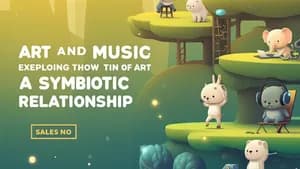Introduction: Bridging the Gap Between Sound and Sight
Music, at its core, is an abstract art form. We experience it through sound waves, interpreted by our brains as melody, harmony, rhythm, and emotion. But how do we translate these intangible experiences into something tangible, something we can see and analyze? This is where the visual arts step in, offering a powerful lens through which to explore the complexities of music. This article will delve into the fascinating world of visualizing music's abstract concepts, specifically dissonance and consonance, demonstrating how artists have successfully transformed these auditory phenomena into compelling visual representations. We'll explore various techniques and provide practical examples to help you better understand and appreciate the relationship between music and art.
Visualizing Dissonance: Chaos and Tension
Dissonance, in music, creates a sense of tension, unease, or even conflict. Think of the unsettling feeling you get from a clashing chord progression. Visually, artists represent dissonance through sharp angles, jarring colors, and fragmented forms. Consider the works of Wassily Kandinsky, a pioneer of abstract art deeply influenced by music. His paintings often reflect the emotional intensity of dissonance, using a chaotic arrangement of colors and shapes to mirror the sonic unease. For example, his painting Improvisation 28 (second version) powerfully conveys this through its dynamic interplay of colors and jagged lines.
To help you visualize dissonance more effectively, try this exercise: Listen to a piece of music known for its dissonant elements, such as some works by Igor Stravinsky or Charles Ives. As you listen, try sketching or painting your immediate impressions. Don't worry about technical skill; focus on capturing the emotional impact through color, line, and form. Experiment with contrasting colors, harsh lines, and fragmented compositions to mirror the dissonance in the music. This hands-on approach will enhance your understanding of how visual elements can represent complex musical ideas.
Visualizing Consonance: Harmony and Balance
Consonance, in contrast to dissonance, produces a sense of stability, harmony, and resolution. Pleasant chord progressions and smooth melodic lines are characteristics of consonant music. Artists visually represent consonance using soft curves, balanced compositions, and harmonious color palettes. Think of the serene landscapes of Caspar David Friedrich or the calming compositions of Piet Mondrian. Their artwork often evokes a sense of tranquility and order, directly mirroring the harmonious qualities of consonant music.
To apply this principle practically, listen to a piece of music known for its consonant characteristics, such as some Baroque concertos or classical symphonies. As you listen, try creating a visual representation, focusing on smooth lines, balanced shapes, and harmonious color combinations. Observe how the visual harmony reflects the auditory harmony of the music. You might experiment with gradients, symmetrical designs, and overlapping shapes that create a sense of visual unity and balance, reflecting the smooth transitions and resolutions present in consonant music.
Exploring Techniques: Transforming Sound into Form
Several techniques can be employed to transform abstract musical concepts into visual forms. One approach is to use color to represent pitch, with higher pitches depicted using brighter or warmer colors and lower pitches represented by darker or cooler ones. Another approach is to use the intensity or saturation of the colors to represent dynamics, with louder passages shown as more intense colors and softer passages shown as more muted colors. Rhythm can be visualized using line length, thickness, or the spacing between visual elements, mirroring the musical pulse and phrasing.
You can explore these techniques by selecting a short musical piece and mapping its characteristics onto a visual medium. Start by identifying the piece's key features: melodic contours, rhythmic patterns, and harmonic progressions. Then, create a visual representation where each musical element is assigned a specific visual property. For instance, a rising melody could be expressed through an upward-sloping line, while a repeated rhythmic motif could be shown by repeating a visual shape or pattern. Remember, there's no single ‘right’ way – experiment and find your own unique system of visual translation.
Case Studies: Artwork Inspired by Music
Many artists have created works directly inspired by specific musical compositions. For example, several artists have visually interpreted the works of Claude Debussy. His impressionistic style, with its ethereal and evocative qualities, lends itself beautifully to visual translation. Likewise, the complex harmonies and rhythms of composers like Béla Bartók have inspired abstract artwork mirroring the dynamic energy and intricate structures in his compositions. Studying these visual interpretations can provide insights into the many ways artists have tackled the challenge of conveying abstract musical concepts through different artistic mediums.
To deepen your understanding, research works of art inspired by your favorite composers. Look at how the artist interpreted the emotional tone, rhythm, and harmony of the music. Compare the original musical score with the visual representation to fully appreciate how the artist has successfully translated the essence of the composition into a visual form. Analyzing these pairings will help you develop your own visual language for interpreting music.
Conclusion: A Creative and Analytical Journey
Visualizing music is not merely an artistic exercise; it's a powerful tool for enhancing your understanding and appreciation of musical concepts. By actively engaging with this process—listening critically, experimenting with visual representation, and researching existing visual interpretations of music—you embark on a creative and analytical journey that deepens your understanding of both music and art. This interdisciplinary approach can significantly benefit your studies, fostering critical thinking, creativity, and a deeper appreciation of the multifaceted nature of art.
Remember, the most important aspect of this process is experimentation and exploration. Don’t be afraid to try different techniques and approaches. The goal is not to create a perfect representation but rather to develop your own unique visual language for interpreting music's abstract concepts. This ongoing process of experimentation and discovery will enrich your understanding of music and the arts as a whole.

